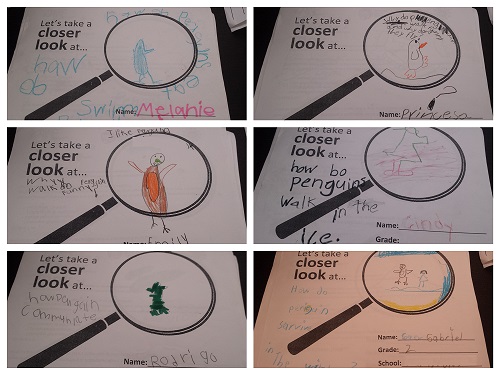When people think “Antarctica” probably one of the first things that comes to mind are the black and white, flightless birds that are highly adapted for life in the water: penguins!
As we travel through the thicker sea ice, we can see groups of Adélie penguins running around with their wings out and emperor penguins
stoically standing, just watching us go by.

I received a LOT of requests to take a closer look at penguins and some very good questions about them.
Let’s take a closer look at Penguins

Penguins are flightless, aquatic birds that live in the southern hemisphere. They are highly adapted for life in the water: their wings have evolved into flippers, unlike other birds they have heavy solid bones and they have countershaded (a type of camouflage) black and white feathers to help them avoid predators in the water. They have oily un-wettable feathers and can hold their breath from 15-25 minutes depending on the species. Some penguins can dive as deep as 275 feet!


- How do penguins survive in the winter and cold? Gabriel, 2nd grade
Though not all penguins live in cold environments, those that do are specially adapted to stay warm. Penguins have soft down feathers and a thick layer of fat, called blubber, to help them survive below freezing temperatures. They also have highly specialized metabolisms and circulatory systems that help them keep their body insulated and not lose heat to the cold air.
- How do penguins eat? And swim? – Melanie, 1st grade
Penguins swim through the water by flapping their wings, which work like flippers. Penguins are graceful swimmers, reaching speeds of about 7.5 miles per hour (though speeds of 17 mph have been recorded!) while looking for fish or krill to eat that they snap up with their sharp beaks. Though as they look for food they also have to beware of killer whales and leopard seals that might try and make a meal out of them.
- Why do penguins walk funny and why don’t they fly? – Princessa, 2nd grade
- How to penguins walk on in the ice? – Cindy, 2nd Grade
- Why do penguins walk funny? – Emily, 1st grade
Sometimes we can spot penguins walking over the ice, or even sliding on the ground on their bellies. It may seem to us that penguins walk funny, but this is because their body is designed for swimming! Adult penguins have no natural predators on land (only in the water) so there is no need for them to run fast or fly, an ability they lost a long time ago.
- How do penguins communicate? –Rodrigo, 1st
They communicate with vocalizations, squawks, songs, and calls. And with visual behaviors and movements, parents and chicks can recognize each other’s calls, even out of the thousands of other penguins around.
- Can I play with a penguin? –Seth, 2nd grade
Unfortunately we cannot play with the penguins. They are wild animals and we must let them be go about their lives. Even if a penguin walks through our research area or research station we have to get out of their way and let them keep walking!
Try it at Home
The shortest penguins in the world are little blue penguins, or fairy penguins, from Australia that are about 16 inches tall.
The tallest penguins in the world are the emperor penguins in Antarctica, which are about 3 and a half feet tall.

1) Grab a ruler, pencil and some post it notes and head to your nearest wall. 2) Write the penguin names on your post-it notes. Don’t write on your wall! 3) Using your ruler, measure the height of a penguin and mark it with your post-it note. Remember, don’t write on your wall! 4) Now (you may want the help of a friend or parent for this), measure your own height and mark this on the wall with a post-it note.
Antarctic Penguin Heights: Emperor Penguin – 3 and 1/2 feet King Penguin - 3 feet Gentoo Penguin - 2 and 3/4 feet Adélie Penguins – 2 and 1/4 feet Chinstrap Penguins – 2 feet Rockhopper Penguin – 1 and 3/4 feet Macaroni Penguin – 2 and ¼ feet
Which penguins are you taller than? Are you shorter than any penguins? Which penguin is closest to your height?
I’m only 1 and 1/5 feet taller than an emperor penguin!



Comments